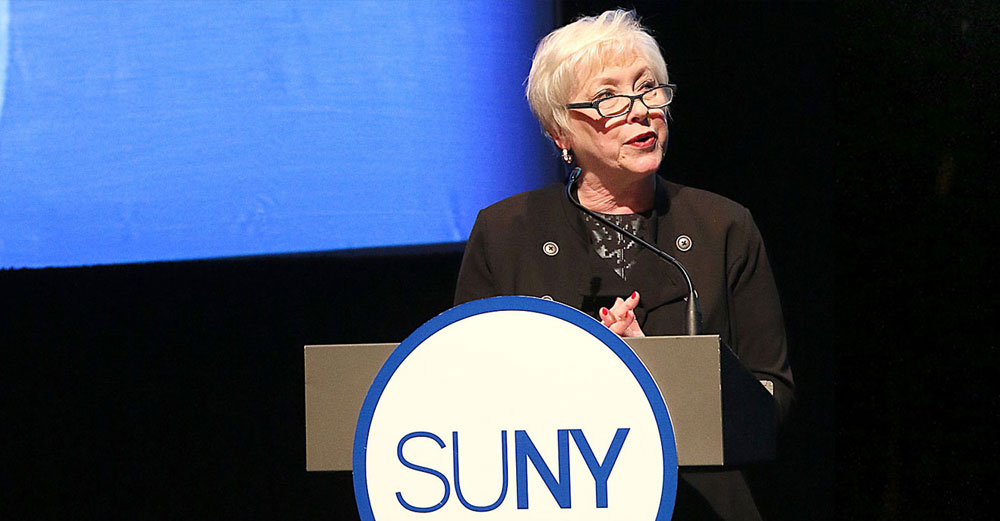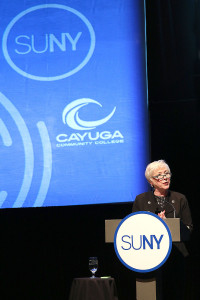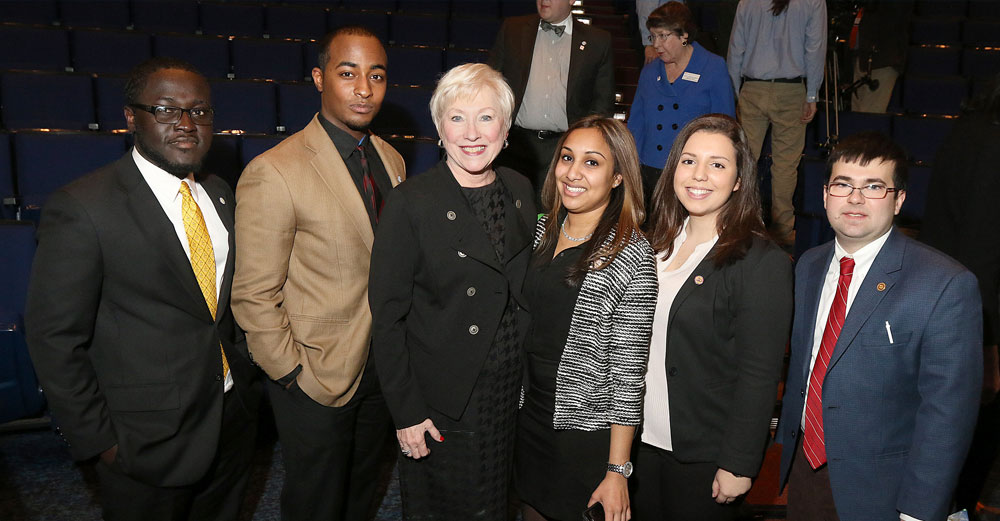
You may have noticed that the Big Ideas Blog was silent this week with no new posts. Fear not, loyal readers. The Offices of Communications and New Media were busy preparing for the annual SUNY State of the University address, in which Chancellow Nancy Zimpher presents a year’s worth of review, oversight, and new initiatives for the more than 460,000 SUNY students and nearly 90,000 employees across New York State.
Last year, we saw the introduction of Open SUNY, the comprehensive online learning network set to provide more learning access to students across New York, and an expansion of SUNY Works, the cooperative education and paid internship initiative, among many other items.
What is in store for 2015?
Today, Chancellor Zimpher delivered her fifth annual State of the University Address in The Egg’s Swyer Theater in Albany. As is tradition now, the event kicked off with a video of SUNY schools showing their students and staff in various activities on and around campus. This year’s video was dubbed #SUNYselfie, taking a piece out of the still growing trend of people everywhere taking selfies to remember moments and places in life. Check out the video below:
After the video ended, Chancellor Zimpher decided to take a selfie herself with the attendees seated behind her. And then it was down to business, and on to the 2015 State of the University Address.
Throughout the speech, Chancellor Zimpher called for increased investment in the system which will enable SUNY to scale evidence-based best practices to drive a higher degree of access, completion, and success for SUNY’s current students and future graduates.
“An investment in SUNY is an investment in the future of New York State,” said Chancellor Zimpher. “SUNY functions like a central nervous system for the state—an economic and quality-of-life driver unlike any other—and benefits everyone who lives, works, and does business here, now and in the future. Education is simply the best investment the state can make.”
SUNY will work with its campuses to build state and philanthropic support for an investment fund that will drive the expansion of proven student interventions and bring strategies to scale across the system.
 To ensure excellence in the results produced by this investment fund, and in response to Governor Andrew M. Cuomo’s call for performance-based funding plans in his 2015 State of Opportunity Agenda, SUNY will hold itself accountable to its stakeholders through “SUNY Excels,” a performance management system that will measure the university’s achievements at the system and campus levels. SUNY Excels was developed over the last two years and will drive the next phase of the University-wide strategic plan, The Power of SUNY 2020.
To ensure excellence in the results produced by this investment fund, and in response to Governor Andrew M. Cuomo’s call for performance-based funding plans in his 2015 State of Opportunity Agenda, SUNY will hold itself accountable to its stakeholders through “SUNY Excels,” a performance management system that will measure the university’s achievements at the system and campus levels. SUNY Excels was developed over the last two years and will drive the next phase of the University-wide strategic plan, The Power of SUNY 2020.
Creating SUNY’s most sophisticated performance management system was a systemic, deliberative, and highly consultative process that included input from trustees, presidents, chief academic and enrollment officers, faculty and student governance leaders, and other stakeholders throughout SUNY. The performance management system focuses around five priority areas – access, completion, success, inquiry, and engagement – to track SUNY’s progress and continuous improvement toward excellence.
Chancellor Zimpher also set an ambitious goal for the system to graduate 150,000 students per year by 2020. Currently, SUNY graduates approximately 93,000 students per year. Achieving this goal would be made possible through a robust investment fund and could enable SUNY to single handedly close New York State’s degree attainment gap among working-age adults in less than a decade.
Additionally, every SUNY degree will include an applied learning or internship opportunity as a prerequisite to graduation, so that every graduate leaves campus with hands-on work experience that has prepared them to succeed in their chosen career. The initiative launched by Chancellor Zimpher in her 2014 address is supported by Governor Cuomo’s proposal to bring applied learning to every undergraduate beginning with those first enrolled in the 2015-16 school year. To bring applied learning and internship opportunities to SUNY’s 460,000 students, SUNY has formed strategic partnerships with the Business-Higher Education Forum (BHEF), The Business Council of New York State, the Partnership for New York City, and the Rochester Business Alliance.
“SUNY is out-performing its national counterparts, but we still have a long way to go in our goal of providing access to high-quality, affordable education to every single New Yorker,” said Chancellor Zimpher. “That’s why SUNY is renewing our commitment not only to educating more students, but also to educating them better. We want to take best practices from campuses across the system to the broadest possible scale, but it will require better, smarter investment from the state and philanthropic partners and continued relationships with our local businesses and industry partners.”
In her remarks, Chancellor Zimpher highlighted the following initiatives to create higher degrees of access, completion, and success:
Access
- Early Advisement – SUNY will partner with its k-12 partners to place a SUNY college advisor in every school district across the state, starting with low-income districts.
- College Readiness MOOC – SUNY will launch a Massive Open Online Course in college readiness for all high school students and their families that promotes every aspect of college preparedness, not just academic skills but also admissions, career placement, pursuit of grants and scholarships, and financial aid.
- Electronic High School Transcripts – SUNY will advocate for a common electronic transcript to be used by all of New York’s 698 school districts to help colleges analyze new students and better advise them on their degree path.
- Educational Opportunity Program – SUNY will seek investment and support to expand the Educational Opportunity Programs now in place at 43 SUNY campuses. These proven programs have an unprecedented demand of over 30,000 applicants for only 2,500 seats.
- Chief Diversity Officers at Every Campus – In response to the recommendations of the Diversity Task Force launched in last year’s State of the University Address, SUNY will require a Chief Diversity Officer at every campus who is focused on attracting and retaining diverse students, faculty, and staff, and that goes above and beyond federal reporting requirements to help meet goals in retention, completion, and success for every member of the SUNY family.
Completion
- Remediation – SUNY will expand the implementation of the highly successful Quantway and Statway remediation programs developed by the Carnegie Foundation from 10 of its community colleges to all 30.
- Finish in Four – SUNY will make Finish in Four programs available to all students who want them and ensure that if a student fails to graduate on time due to course unavailability, they can take the course tuition-free. SUNY will also work to build similar programs for its graduate students.
- Open SUNY – Building on last year’s groundbreaking launch of its system-wide online learning platform, SUNY seeks an investment to make critical online support and advising services available to every online student and to maintain quality assurance in online education.
Success
- Master Innovators – SUNY will build on the Governor’s Master Researchers program to recruit and retain highly successful research faculty who will not only drive billions of dollars in sponsored research expenditures throughout Upstate New York but also provide invaluable research opportunities for our students.
- SUNY Works – SUNY will realize its commitment to provide an applied learning opportunity to every graduate by partnering with business and industry.
All in all, the event lived up to its expectations. We look forward to the next year to see the new investments and initiatives develop across our SUNY System.




